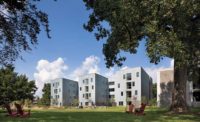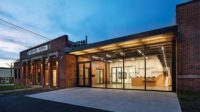Buffalo had its heyday in the 19th century as a busy trade port that prospered with the opening of the Erie Canal. It was rich with architecture and culture. In the 20th century, however, the canal’s importance diminished, and the city suffered a long period of decline. Now it is trying to reinvent itself, in part through exploiting its architectural and civic assets—such as Frank Lloyd Wright’s Darwin D. Martin House Complex and a network of parks and parkways by Frederick Law Olmsted and Calvert Vaux—by breathing new life into them. The ambitious centerpiece of this effort is the revival of the Richardson Olmsted Campus. Once known as the Buffalo State Asylum for the Insane, the complex, now a National Historic Landmark, consists of a majestic 1,500-foot-long army of stone and brick buildings by Henry Hobson Richardson that are surrounded by 100 acres of grounds originally conceived by Olmsted and Vaux. The principal element of the first phase is the new Hotel Henry, a boutique “urban resort” and conference and event center designed by New York architects Deborah Berke Partners (DBP) that opened in April. Embracing the center’s past while reinventing it for modern use, the hotel and its stylish, minimal interiors provide a sympathetic counterpoint to the coarse and imposing walls outside.
Additional Content:
Jump to credits & specifications
Richardson’s design for the rambling complex, which opened in 1881, was based on the popular “Kirkbride Plan” developed by psychiatrist Thomas Story Kirkbride, whose innovative treatment philosophy emphasized therapeutic environments that harnessed the restorative potential of daylight, air, and pleasing spaces and views. For his design, Richardson hewed to the plan by creating a central Administration Building, announced by two 180-foot-tall ornamental towers, flanked on either side by five wards connected by curved corridors. In plan, the building, which is clad in rusticated Medina sandstone and brick, steps back in the signature Kirkbride “batwing” shape, its narrow profile assuring ample views of the grounds. Over the years, however, as mental-health treatment approaches shifted, the hospital left the facility and, after 1974, the buildings remained mostly vacant.
In 2006, in an attempt to save the deteriorating complex and drive recovery for the larger city, the Richardson Center Corporation (RCC) was founded. “The hope,” says RCC executive director Monica Pellegrino Faix, “was that it would become an economic engine for Buffalo.” Bolstered by $76.5 million in state funding, the corporation stabilized the buildings and developed studies and a master plan that would guide the future use of the property. To boost tourism and promote architecture, while still providing access to the public, this first phase includes the 88-room hotel, which occupies the central Administration Building and one wing on either side, as well as the 3,000-square-foot Lipsey Buffalo Architecture Center at ground level. The hope was also to prompt private investment in the remaining two-thirds of the 500,000-square-foot complex, which is currently vacant.
In 2012, DBP joined preservation consultants Goody Clancy and architect of record Flynn Battaglia on the project, bringing its extensive experience adapting old buildings for the 21c Museum Hotels. But, points out Berke, “Adaptive reuse is the only parallel here. This goes beyond that. It’s H.H. Richardson. It’s intimidating. It’s in a whole other league.” The architects developed a central strategy to guide the design: always take cues from the original architecture. “Not in the manner of worship-at-the-feet-of preservation, as though the building is an icon or relic,” says Berke, “but because it’s a great building by a great architect. This can lead you toward a 21st-century interpretation.” “And,” adds senior principal Stephen Brockman, “we were going to push boundaries a little bit.”
The most conspicuous move is at the main entrance, which the team relocated from the south to the north side of the Administration Building and enclosed in a glass box. The north side sits at a lower grade, so a precast concrete stair with glass guardrails leads up to the historic entry level. The team designed a restaurant, café, and lounges in former offices here, altering the original floor plan as little as possible. Numerous meeting and event rooms occupy the levels above. It is in the hushed guest room wings—with their 14½-foot-wide, south-facing corridors, where patients once spent time taking in the sun—that visitors find one of the building’s most defining features. “Maintaining the single-loaded hallways and figuring out how to make guest rooms in this complicated floor plan was the challenge and excitement of the project,” says Berke, noting that they resisted the impulse to flip the plan, building the guest rooms in the brighter, wide hallway spaces. Instead, the guest rooms, with their grand proportions, large windows, and elegantly spare furnishings, occupy the narrow former patient rooms—only 11 to 12 feet wide. To accommodate bathrooms, the architects created wood bump-outs along the hall that are surprisingly unobtrusive, appearing as armoires or other furniture. “The hospitality handbook—which dedicates most space to guest rooms—does not have this in there,” notes Brockman. “Here we had complete imbalance, but it was important that people experience the gracious spaces this building originally had.”
The team maintained and restored many existing elements: maple flooring, molding, windows. And they called out their interventions, for example differentiating new walls with materials other than plaster. In many places, soffits accommodate lighting as well as mechanicals. And the architects took care to avoid hospitality-appropriate finishes that were too institutional, given the facility’s past. “There are all these weird parallels,” says Brockman, “so things like color became a huge topic of conversation.” A palette evolved of soothing, muted pale greens and blues, complemented by contemporary works by Buffalo artists. Entering Hotel Henry is like cracking open a tough carapace to reveal a rich, inviting interior. “The building has a really powerful presence,” says Berke. “What we tried to do was celebrate it—allow people to enjoy that presence—while distancing the hotel from the asylum and embracing the architecture.”
CreditsArchitect: Deborah Berke Partners — Deborah Berke, Stephen Brockman, Gunnar Burke, Virginia Gray, Brendan Lee, John Midgette, Alessandro Preda, Alexandra Tailer, Yasemin Tarhan, Olivia Susai, Stephen Lam
Architect of Record/Design-Team Coordinator: Flynn Bataglia Architects
Engineers Buffalo Engineering (m/e/p); Simpson Gumpertz & Heger (structural); Watts Architecture & Engineering (civil)
Consultants Goody Clancy (exterior historic preservation); Flynn Battaglia Architects (interior historic preservation & tax credit); Kugler Ning Lighting
Construction manager: LP Ciminelli |
SpecificationsCurtain wall Tubelite
Acoustic ceilings Armstrong
Floor and wall tile Porcelanosa
Carpet and rugs Signature, Durkan (with design by Deborah Berke Partners) |














Post a comment to this article
Report Abusive Comment